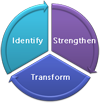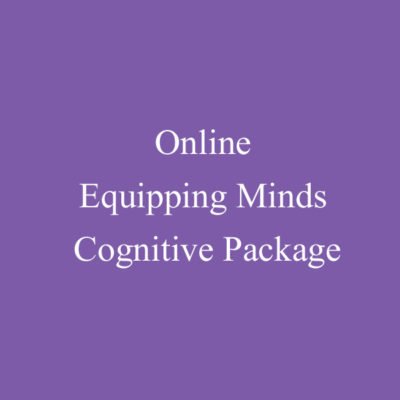Primitive reflexes are automatic, involuntary movements necessary to a baby’s survival in the first few weeks of life. These involuntary reflexes are quickly inhibited as higher centers of the brain develop and voluntary responses dominant. Primitive reflexes persisting beyond 6-12 months of life are considered abnormal.
Normal neural development shows a progressive inhibition of the primitive reflexes and progressive development of new skills such as gross motor skills, fine motor skills, along with crawling, walking, balance, coordination, and speech. Children sometimes have a number of persistent primitive reflexes present with neuro-developmental disorders. The severity of this neuro-developmental delay depends upon the strength and number of the persistent primitive reflexes, as well as other factors.
What to do?
The primitive reflexes can be remediated at home via primitive reflex exercises. You may purchase a the course from the Equipping Minds SHOP.
Below you will find common signs and symptoms associated with a persistent primitive reflex and informative videos. The list is not complete, but is intended to offer some insight regarding the importance of primitive reflex testing and correction.
Moro Reflex – Sensory Systems affected: Auditory, Tactile, Visual, Vestibular & Proprioceptive
The Moro Reflex emerges at 9 weeks in utero and is the earliest form of “fight or flight” (reaction to stress) which is fully present at birth and is usually inhibited between 2-4 months of life.
School Problems
- Over reactive
- Hypersensitive
- Stimulus bound
- Difficulty with ball games
General signs of retention:
- Car sickness or poor balance and coordination
- Poor stamina
- Doesn’t maintain eye contact
- Sensitive to light
- Sensitive to sound
- Allergies
- Adverse reaction to drugs
- Hypoglycemia
- Dislike of change
- Anxiety or nervousness
- Mood swings
- Poor math sense
Tonic Labyrinthine Reflex – Sensory Systems Involved: Vestibular, Proprioceptive, Auditory, and Visual
The Tonic Labyrinthine Reflex (TLR) emerges in utero, is fully present at birth and is inhibited by 4 months and is closely linked to the Moro Reflex as both are vestibular in origin and activated by movement of the head. When retained can lead to spatial problems, poor posture & muscle tone, motion sickness, visual perceptual difficulties, poor sequencing skills and a poor sense of time. The Tonic Labyrinthine Reflex (TLR) Backwards emerges at birth and is inhibited gradually from 6 weeks to 3 years and is involved in the simultaneous development of postural reflexes, symmetrical tonic neck reflex and the Landau reflex can result in poor balance and coordination, organizational skills and stiff jerky movements if retained.
School Problems
- Poor balance, rigid or floppy muscles (seen in PE or in running)
- Oculo-motor dysfunction, tracking, convergence, reestablishment of binocular vision
- Visual perceptual difficulties
- Possible auditory problems
- Organizational problems
- Poor sense of time and rhythm
General Signs of Retention:
- Poor posture
- Weak muscles
- Poor balance
- Unable to cross eyes easily, or it hurts when crossing
- Spatial problems – bumps into furniture, stands too close
- Poor sequencing – telling stories, counting, organizing
- Poor sense of time, unable to tell time
Spinal Galant Reflex – Sensory Systems involved: Auditory, Tactile, and Proprioception
The Spinal Galant emerges at 20 weeks in utero, is actively present at birth and inhibited by 3-9 months. If fully retained, or only retained on one side may affect posture, gait and other forms of locomotion and is responsible for bedwetting, fidgeting, poor concentration and short-term memory, and hip rotation to one side when walking. When retained can interfere with the development of amphibian and segmental rolling reflexes.
School Problems
- Inability to sit still or remain silent
- Poor concentration
- Continued bed wetting above the age of 5 yrs
General Signs of Retention:
- Fidgeting
- Bedwetting
- Poor concentration or attention
- Poor memory
- Poor organization
- Very sensitive to several senses (visual, hearing, touch, smell, taste)
- Auditory processing difficulties
- Difficulty reading
Asymmetrical Tonic Neck Reflex – Sensory Systems Involved: Auditory, Vestibular, Visual, and Proprioceptive
Asymmetrical Tonic Neck Reflex (ATNR) emerges 18 weeks in utero to stimulate the balance mechanism and increase neural connections ATNR. It assists the birth process and is reinforced by the birth process. It is fully present at birth and develops eye-hand coordination, trains one side of the body at a time and extends ability to focus from 17 cm to arms length. It is inhibited about 6 months of life (so that focus on distant objects can develop). It ensures free passage of air when baby is in the prone position and increases extensor muscle tone.
School Problems
- Handwriting: expression of ideas in written form
- Eye tracking problems; difficulty crossing the midline
- Ambilaterality or cross laterality
General Signs of Retention:
- Unable to cross eyes easily, or hurts when crossing
- Eyes jump over words or parts of words, or lines or repeats lines when reading
- Poor balance
- Right-left confusion
- Mixes up “d”s and “b”s or other letters and numbers
- Difficulty skipping or marching
- Poor handwriting
- Poor expression of ideas on paper
Symmetrical Tonic Neck Reflex
The Symmetrical Tonic Neck Reflex (Flexion & Extension) emerges at about 6-9 months of life and is inhibited about 9-11 months. If retained affects posture, hand-eye coordination and swimming skills. Also results in the tendency to slump when sitting at a desk, ape-like walk, difficulties with binocular vision, “clumsy child” syndrome, slowness at copying tasks and messy eating habits.
School Problems
- Posture lies on desk when writing
- Poor eye hand coordination
- Problems with refocusing from far to near distance
- Clumsy
General Signs of Retention:
- Poor posture
- Ape-like walk
- Poor eye-hand coordination
- Messy eater
- Unable to cross eyes easily, or hurts when crossing
- Eyes jump over words or parts of words, or lines or repeats lines when reading
- Slow with copying tasks
- Poor attention skills
Palmer Reflex –Sensory Systems Involved: Tactile and Proprioception
The Palmer Reflex emerges about 4-6 months of age. If retained it affects fine motor skills, pencil grip, posture when writing or at desk, spelling.
School Problems:
- Posture – lies on desk when writing
- Poor pencil grip
- Poor spelling
- Poor handwriting
General Signs of Retention:
- Poor handwriting
- Poor manual dexterity
- Lack of pincer grip
- Speech and articulation issues
- Palm may be hypersensitive to touch
- Makes mouth movements when writing or drawing



